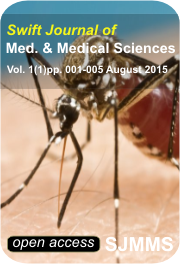Journal Categories

Swift Journal of Medicine and Medical Sciences (SJMMS)
August 2015 Vol. 1(1), pp. 001-005
Copyright © 2015 Swift Journals
Original Research Paper
ENTOMOLOGICAL SURVEY OF MOSQUITOES RESPONSIBLE FOR THE TRANSMISSION OF LYMPHATIC FILARIASIS IN Biase Cross River State, Nigeria
Mbah, M., Akpan, S.S., OtuBassey, I.B.& Daniel, H. B.
Department of Medical Laboratory Science, University of Calabar, Nigeria PMB 1115 Calabar
Department of Microbiology, University of Calabar, Nigeria PMB 1115 Calabar
*Corresponding Author E-mail: mauricembah@yahoo.fr
Accepted 21 July, 2015
Abstract
This work was carried out in Biase, Cross River State, Nigeria from March to June, 2014. A total of 1296 mosquitoes made up of 795 (61.3%) Culex species, 342 (26.4%) Anopheles species, 102 (7.9%) Aedes species, and 57 (4.4%) of other Genera were caught using human bait and pyrethrum spray methods. Of the 1296 mosquitoes caught, 804 (62%) were caught in the rainy season while 492 (38%) were caught during dry season. The number of mosquitoes caught during dry and rainy seasons was statistically significant (X2 = 0.62, P < 0.05). The mosquitoes were segregated into different species and dissected to unveil any microfilaria in the thoracic, abdominal, and mouth part regions. Out of 1213 mosquitoes dissected, 24 (1.9%) had developed stages of L1, L2 and L3 of W. bancrofti, 8 (0.6%) had L3 larvae. Anopheles spp had the highest number of mosquitoes infected 11/329 (3.3%), Culex spp had a 13/743(1.7%) while out of the 98 Aedes species dissected none had any filarial worm seen. Ten (41.6%) larva was found in the head of both Anopheles and culex, while 8(33.3%) and 6 (25%) were found in the thorax and abdomen respectively. The two types of mosquitoes infected was statistically significant (X2=8.28, P>0.05). There was a positive correlation between the infection rate among mosquitoes in the dry and rainy season (r = 0.85, P<0.05).The distribution of filarial larva (L1, L2 and L3) in the body of mosquitoes showed that Out of the 11Anopheles infected, 4 (1.2%) filarial worms were found in the head, 5 (1.4%) in the thorax and 2(0.5%) in the abdomen while out of the 13 culex mosquitoes infected, 6 (0.7%) filarial worm were found in the head, 3(0.4%) in the thorax and 4 (0.5%) in the abdomen. The highest number of filarial worms seen was L3 with 17 (70.8%), followed by L1 with 5 (20.8%) and lastly by L2 with 2 (8.3%). This study has shown that Anopheles species and the Culex species are the vectors of lymphatic filariasis in the study area.
Keywords: Mosquitoes, Transmission, Lymphatic filariasis, Biase
Read [Full Text - PDF]
